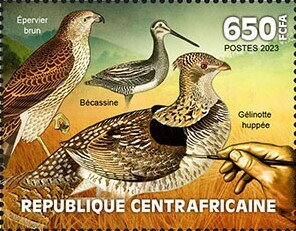Stamp: Brown hawk, Snipe, Ruffed grouse (Central African Republic 2023)
Brown hawk, Snipe, Ruffed grouse (Central African Republic 2023)
05 July (Central African Republic ) within release Alexander Wilson (2023) goes into circulation Stamp Brown hawk, Snipe, Ruffed grouse face value 650 Central African CFA franc
| Stamp Brown hawk, Snipe, Ruffed grouse in catalogues | |
|---|---|
| Yvert et Tellier: | Yt: CF 11100 |
Stamp is square format.
Also in the issue Alexander Wilson (2023):
- Mini Sheet - 210th Anniversary of the Death of Alexander Wilson face value 6*650;
- Stamp - Alexander Wilson 1766–1813, Barred Owl face value 650;
- Stamp - Alexander Wilson 1766–1813, Quail face value 650;
- Stamp - Alexander Wilson 1766–1813, Snow Bunting face value 650;
- Stamp - Brown hawk, Snipe, Ruffed grouse face value 650;
- Stamp - Homing pigeon, Eskimo Curlew face value 650;
- Stamp - Turtle dove face value 650;
Stamp Brown hawk, Snipe, Ruffed grouse it reflects the thematic directions:
Animals are multicellular, eukaryotic organisms of the kingdom Animalia (also called Metazoa). All animals are motile, meaning they can move spontaneously and independently, at some point in their lives. Their body plan eventually becomes fixed as they develop, although some undergo a process of metamorphosis later on in their lives. All animals are heterotrophs: they must ingest other organisms or their products for sustenance.
An anniversary is the date on which an event took place or an institution was founded in a previous year, and may also refer to the commemoration or celebration of that event. For example, the first event is the initial occurrence or, if planned, the inaugural of the event. One year later would be the first anniversary of that event. The word was first used for Catholic feasts to commemorate saints. Most countries celebrate national anniversaries, typically called national days. These could be the date of independence of the nation or the adoption of a new constitution or form of government. The important dates in a sitting monarch's reign may also be commemorated, an event often referred to as a "Jubilee".
Birds (Aves), a subgroup of Reptiles, are the last living examples of Dinosaurs. They are a group of endothermic vertebrates, characterised by feathers, toothless beaked jaws, the laying of hard-shelled eggs, a high metabolic rate, a four-chambered heart, and a strong yet lightweight skeleton. Birds live worldwide and range in size from the 5 cm (2 in) bee hummingbird to the 2.75 m (9 ft) ostrich. They rank as the class of tetrapods with the most living species, at approximately ten thousand, with more than half of these being passerines, sometimes known as perching birds. Birds are the closest living relatives of crocodilians.
Birds of prey or predatory birds, also known as raptors, are hypercarnivorous bird species that actively hunt and feed on other vertebrates (mainly mammals, reptiles and smaller birds). In addition to speed and strength, these predators have keen eyesight for detecting prey from a distance or during flight, strong feet with sharp talons for grasping or killing prey, and powerful, curved beaks for tearing off flesh. Although predatory birds primarily hunt live prey, many species (such as fish eagles, vultures and condors) also scavenge and eat carrion




